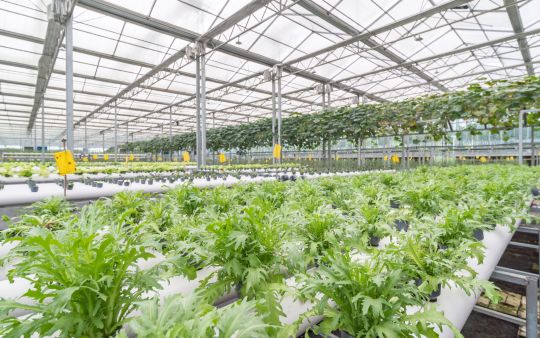
Articles by Industry: Agriculture | Benefits of Dry Fog in CEA | Greenhouse Humidity Management | Advanced Humidification for Indoor Farming | Optimize Crop Yield | Sustainable Farming


Airflow is one of the most widely discussed topics in controlled growing environments, and for good reason. Circulation supports temperature regulation, encourages healthy transpiration, strengthens plant structure, and helps prevent stagnant zones. But when it comes to managing mold and fungal risk, airflow alone is not enough. In some cases, it may even be making things worse.
Let’s explore how air movement interacts with humidity and why stability, not just circulation, is key to mold prevention.
Fans are typically used to prevent moisture buildup on plant surfaces. The idea is that moving air keeps surfaces dry, which discourages mold development. While this can be partially effective, it does not address the real issue: the total amount of moisture in the air.
If the relative humidity (RH) in the space is already high, fans only redistribute that moisture. They do not remove it. And because mold spores are nearly always present in the environment, fans can also spread them throughout the room. According to research from the University of Arizona’s Controlled Environment Agriculture Center, airflow can help or hinder disease control depending on how it interacts with other environmental factors like RH, leaf temperature, and condensation.
Without real-time humidity control, airflow systems are reactive. They respond after RH has already spiked, especially during lights-off cycles when the air cools and RH naturally increases. These spikes can lead to condensation forming on leaves and hard surfaces, creating microzones where mold thrives.
Grow rooms often develop microclimates, especially in areas where air does not circulate evenly. Dense canopies, corners, poorly ventilated walls, and even equipment placements can cause localized humidity buildup. These areas may stay warmer, wetter, or more stagnant than the rest of the space.
Mold does not need the entire room to be out of spec. It only needs a pocket of stagnant, moist air with temperatures in the right range. These pockets form easily in environments where air moves, but moisture is not actively managed. Studies have shown that most fungal pathogens thrive in RH ranges above 85 percent and that condensation on surfaces further increases risk.
Traditional ventilation systems are rarely designed to respond to this kind of spatial variation. Fans typically operate at set speeds and cannot adjust to minor environmental shifts. They improve airflow but do not eliminate high humidity or condensation risks on their own.
The most effective way to prevent mold is to stabilize the environment. Instead of relying on fans to push around moist air, growers can benefit from systems that manage RH precisely, adding or removing moisture as needed.
Dry Fog systems are one example. They work by introducing ultra-fine droplets that evaporate immediately into the air. Because the particles are so small (under 10 microns), they do not settle on surfaces or cause wet spots. This makes it possible to increase ambient humidity in a uniform, controlled way without increasing mold risk.
When paired with environmental sensors, Dry Fog systems can react in real time to maintain steady RH, even as temperatures shift between day and night cycles. The result is less condensation, fewer humidity spikes, and a more consistent environment overall.
Mold control is often treated as an afterthought; cut off the affected leaves, crank up the airflow, and apply a fungicide. But these are reactive steps. The better strategy is to prevent the conditions that allow mold to take hold in the first place.
That means focusing on consistency. Temperature, humidity, and airflow should all be coordinated to create a stable environment. Airflow is essential, but it must be paired with humidity control to be truly effective.
By rethinking how air and moisture are managed together, cultivators can reduce risk, increase crop quality, and operate more efficiently without relying on constant interventions.


Articles by Industry: Agriculture | Benefits of Dry Fog in CEA | Greenhouse Humidity Management | Advanced Humidification for Indoor Farming | Optimize Crop Yield | Sustainable Farming

Dry Fog For Cannabis Cultivation | How to Grow Quality Bud | Indoor Grow for Cannabis

Humidity: The Hidden Ingredient for Healthier Crops & Higher Yields